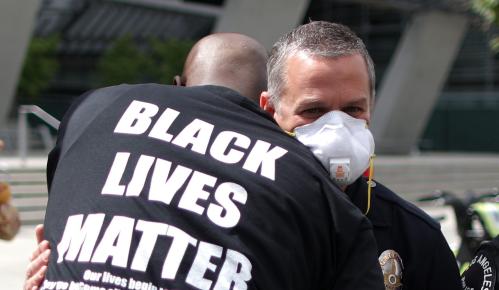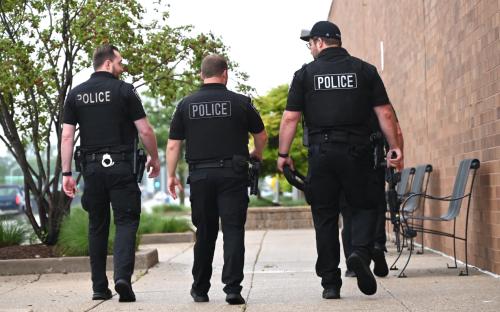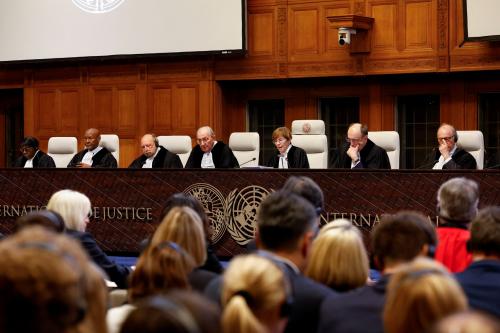In the wake of many high-profile, officer-involved shootings—particularly involving Black Americans—civilians, the media, and politicians have become increasingly critical of American policing. While new policies and technologies have been aimed at addressing public concern, there remains a lot of work to be done to improve the experiences of police officers and police culture.
At an Oct. 25 event, Brookings brought together an expert panel to discuss the state of American policing, as well as the roadblocks and solutions to implementing effective reform. The event featured: Nancy La Vigne, vice president of justice policy at the Urban Institute; Capt. Joe Perez, president of the Hispanic National Law Enforcement Association; and Rashawn Ray, a David M. Rubenstein Fellow at Brookings. Senior Fellow Vanessa Williamson served as moderator.
The event, which is available to watch below, was put on by Brookings’s Race, Prosperity, and Inclusion Initiative.
Policing culture
Experts began the conversation by discussing the biggest challenges facing policing. The panelists agreed many issues stem from the toxic culture fostered by police recruitment, training, and leadership.
Perez, previously a captain of the Prince George’s Police Department, described the pattern of “heavy handed” policing that permeates police leadership and training practices. With a significant focus on officer safety, he said police training often pits officers against the community they serve.
La Vigne noted the presence of a “warrior mentality” imbued in police training and recruitment. She said this reputation attracts a subset of individuals who may not always be the best fit to deal with the social work issues prevalent on the front lines of policing.
Ray explained how the organizational structure and culture of policing fuels what he sees as the most detrimental challenge: a lack of transparency and accountability. Policies aimed at reform, including implicit bias training and body camera use, fall short because they don’t address the root causes of incidents, such as officer-involved shootings. Other ways of resolving internal policing issues, such as civil payouts, mean taxpayer dollars resolve issues with problem police officers rather than indictment or trial.
Perez also acknowledged the frequent use of internal cover-ups within police departments to protect officers who are habitual offenders of excessive use of force. In referencing recent high-profile incidents, Perez said the officers likely had a history of prior incidents that were swept under the rug. Over the course of his own career, Perez said he observed patterns of cover-up where police leadership would label a repeat offender as a “good worker” or “hard charger” without acting on their behavior. “Had [police] done what we were supposed to do from the beginning, we may have prevented some of these high-profile incidents,” Perez said.
The police experience
Panelists also discussed the implications of the police officer experience, noting the unique challenges of the job. Perez noted that there is no “one size fits all” for the day-to-day job of a patrol officer, meaning the intensity and frequency of work varies widely. He described how serious situations may arise with barely a moment’s notice. “When you’re called to these dangerous situations, or for dangerous people or incidents, that’s all of a sudden—that’s a split second,” said Perez. “You could go from zero to one hundred … in a matter of seconds.”
Perez explained that police are often trained to see the community as the enemy. Officers who connect with their community are far less likely to be recognized than those who make many arrests, especially ones involving force.
Ray also acknowledged how data on policing reflect this misguided reward structure. “We are getting a lot of information on officers that do things that we consider to be bad,” Ray said. “But we don’t have any information on officers who do things that we consider to be good. And that is ultimately what we need because, when it comes to training, we need to be able to replicate some of the characteristics that we see that are positive outcomes.”
And while policy changes are being made, little is being done to address the staggering statistics on officer mental health. Ray cited a study saying 80% of officers have some type of chronic stress—with significant amounts of those experiencing suicidal thoughts and/or substance abuse problems. Compounding this, 90% of officers reported being reluctant to seek help due to a stigma associated with therapy. According to Ray, the solution is to normalize mental health care through efforts like requiring that officers visit a psychologist or psychiatrist on a periodic basis.
Reforming the institution
Throughout the event, the panelists often returned to what can be done to make new policies, such as body cameras, virtual reality training, and data gathering, more effective in police reform.
On the implementation of new technologies, La Vigne said that innovations are most likely to be effective when a police agency is intentional about how these technologies are used, informs the community about them before they’re deployed, and carefully trains officers on how and how not to utilize the resources. “By and large, most agencies fall short on one or more of those factors,” La Vigne said
Ray added that new policies are often decided upon by senior, front-facing officials, but then left to be executed by lower-level staff who may not have the skillset or people-power to do so.
All three experts acknowledged the potential value in having police departments work with the community they serve, as well as the need for improved federal oversight of policies. They also expressed the positive impact of consent decrees, binding agreements overseen by the courts that can mandate change in police departments.
The Brookings Institution is committed to quality, independence, and impact.
We are supported by a diverse array of funders. In line with our values and policies, each Brookings publication represents the sole views of its author(s).






Commentary
Highlights: Improving police culture in America
November 4, 2019